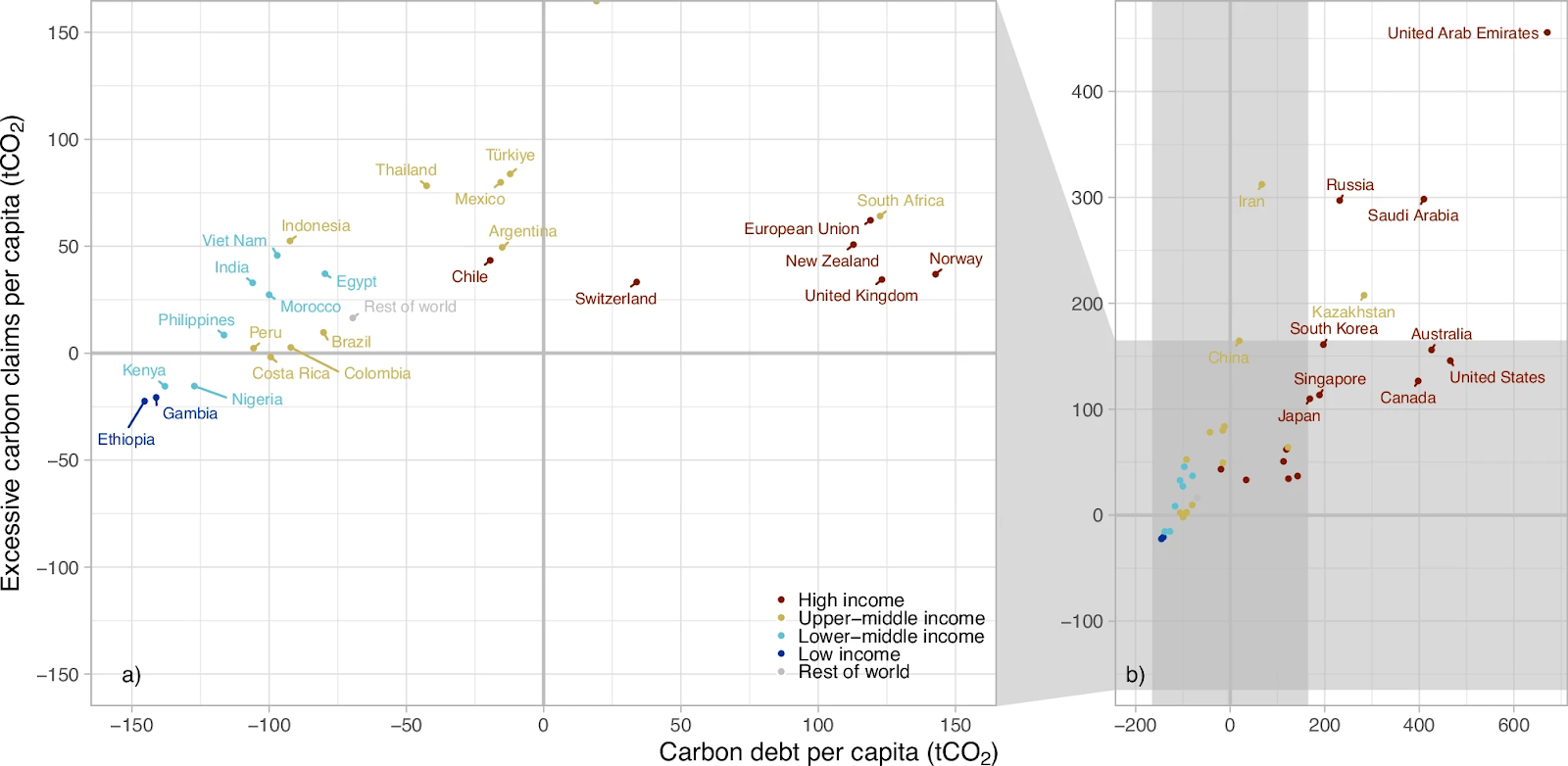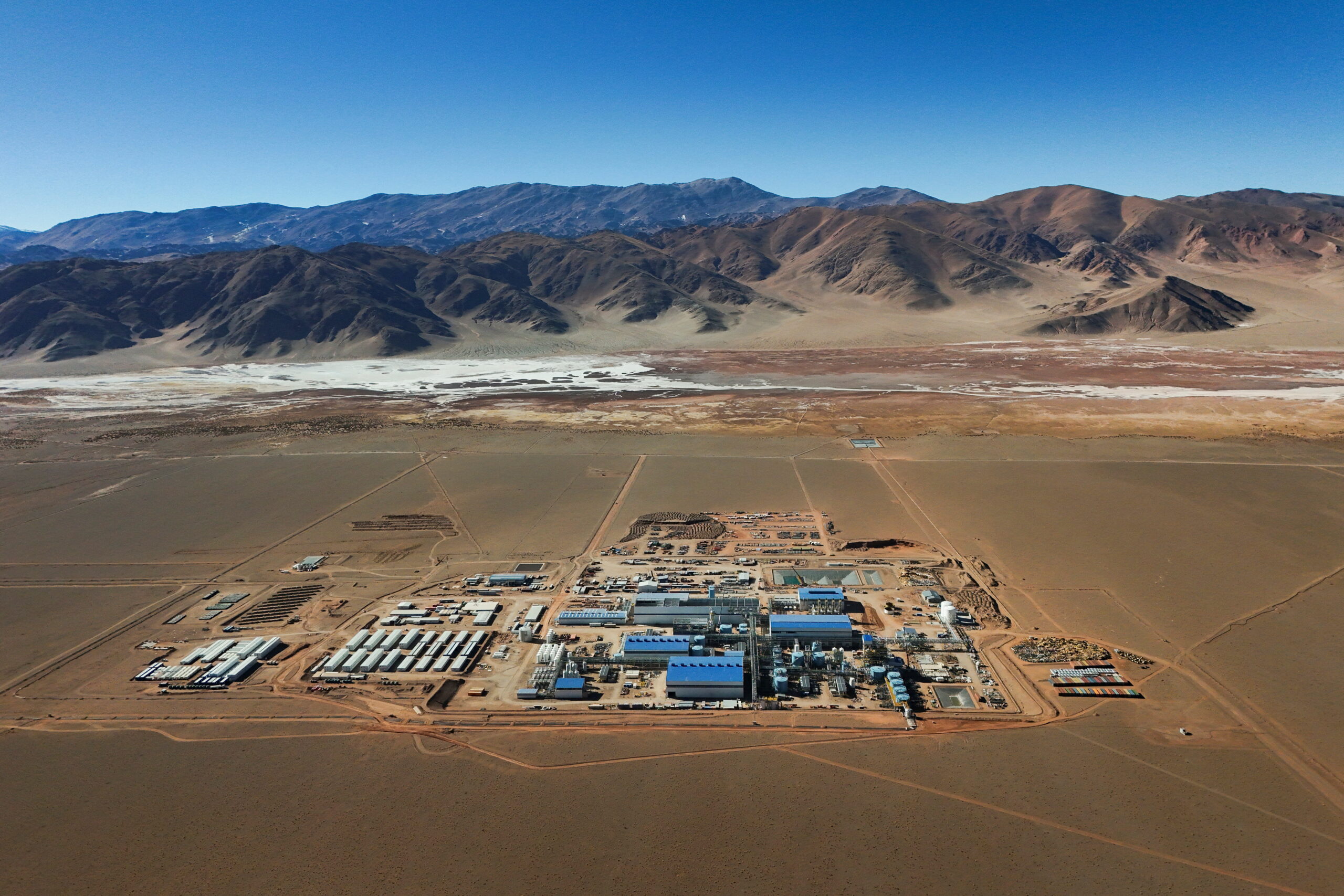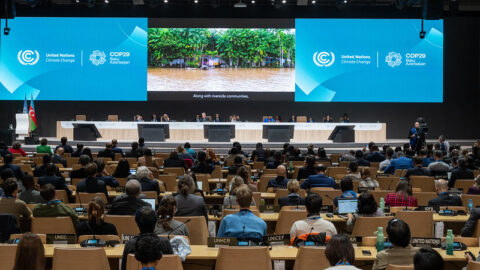Thomas Hahn is associate professor at the Stockholm Resilience Centre and Stockholm University research leader for FAIRTRANS. Robert Höglund is a carbon removal advisor with Marginal Carbon. Mikael Karlsson is associate professor at Uppsala University and research leader for FAIRTRANS.
Recent news articles, in the Guardian and from Bloomberg among others, have proclaimed the death of the 1.5°C target given how emissions and lack of sharper commitments are developing. In a new study, in Nature Communications we examine how the responsibility to limit long-term warming to 1.5°C could be allocated after a temporary overshoot, if countries are held accountable in line with the principle of Common But Differentiated Responsibility and Respective Capabilities (CBDR-RC) as established under the UNFCCC.
This principle, a cornerstone of climate diplomacy, recognizes that while all countries share responsibility for addressing climate change, their obligations differ based on historical emissions and capacity to act. By comparing countries’ past emissions and future emission claims with their equal cumulative per capita emissions, we establish a new indicator – “additional carbon accountability” – showing countries’ responsibilities beyond current climate targets.
If existing national climate targets are met, the 1.5°C fossil carbon budget (for a 50% probability of meeting that goal) will be exceeded with 576 billion tonnes of carbon dioxide (GtCO₂). To meet the 1.5°C target, our indicator shows that the EU, China, the US, and 15 other countries must sharpen their own current targets with faster mitigation and more carbon dioxide removal (CDR), such as afforestation and technical solutions like direct air capture and biochar. All other countries must stick to their national climate plans (nationally determined contributions – NDCs) and net-zero targets.
Counting future emissions
As an example, the EU would need to mitigate or remove an additional 48 GtCO₂ or finance additional reductions beyond current targets in other countries, on top of reaching its own targets in terms of the NDC for 2030 and net zero emissions by 2050. For China, the additional carbon accountability is 150 GtCO₂ and for the USA 167 GtCO₂.

While there is no international agreement on how to operationalize the fairness principles of the Paris Agreement, the new indicator – based on the CBDR-RC – provides an important tool to clarify what different countries are accountable for in relation to the mitigation (emissions) gap. This information feeds directly into the contested annual negotiations on climate financing within the UNFCCC COP meetings.
In general, high-income countries have large carbon debts, while several of the BRICS and upper-middle-income countries have high planned future emissions. Much focus of climate advocacy has been on getting high-income countries to reduce their emissions. Of planned future emissions, 26% come from high-income countries, but as much as 38% comes from upper-middle-income countries with an additional carbon accountability.
China and Iran, for example, have plans for large future emissions and could theoretically meet a large part of their accountability by achieving stricter reduction targets. But countries that have most of their emissions in the past, like the US and the EU, need to turn to not only stricter targets but also CDR, ensuring net negative outcomes.
National responsibility
Unlike the COP29 outcome on financing, which hinges on the division between developed and developing countries, our indicator assigns responsibility to individual countries based on their additional carbon accountability. This approach bypasses the debate over whether only developed countries should collectively finance emissions reductions in developing countries, instead focusing solely on national accountability for emissions.
In the article, we also calculate what it would cost to meet the accountability with CDR or reductions if the cost is $150 per tonne of carbon dioxide. For Iran, the total additional carbon accountability cost would be 1,200% of its GDP in 2021, Russia 530%, China 130%, the US 110%, and the EU 41%.
Our article points to how the responsibility to stay under 1.5°C in the long term could be allocated in line with the CBDR-RC principle. But will countries shoulder this responsibility?
Political will in short supply
For most high-income countries, the focus in practice is more on meeting existing targets, with the topic of paying for historic carbon debt absent. There is also no agreement among countries on how to operationalize the CBDR-RC principle. And few would expect countries like Russia and Iran to make radical emissions reduction cuts, not to mention taking any responsibility for historic emissions.
Hence, it does not seem very likely from the current political situation that countries would increase the ambitions of their national climate plans and net zero targets enough to meet their additional carbon accountability. However, what seems unlikely today can change.
Moreover, every fraction of a degree matters, and our indicator can be used also for other temperature targets, such as 1.7°C or 2.0°C. Our results can be used to put higher pressure on individual countries with plans for large future emissions and to start holding countries with large carbon debts accountable for their historic emissions.
Dr. Ingo Fetzer, a researcher on global systems analyses with the Stockholm Resilience Centre at Stockholm University and Dr. Johannes Morfeldt, a researcher in climate and energy systems at Chalmers University of Technology also contributed to this article.
The post How to resuscitate 1.5°C by identifying accountable countries appeared first on Climate Home News.
How to resuscitate 1.5°C by identifying accountable countries
Climate Change
Efforts to green lithium extraction face scrutiny over water use
Mining companies are showcasing new technologies which they say could extract more lithium – a key ingredient for electric vehicle (EV) batteries – from South America’s vast, dry salt flats with lower environmental impacts.
But environmentalists question whether the expensive technology is ready to be rolled out at scale, while scientists warn it could worsen the depletion of scarce freshwater resources in the region and say more research is needed.
The “lithium triangle” – an area spanning Argentina, Bolivia and Chile – holds more than half of the world’s known lithium reserves. Here, lithium is found in salty brine beneath the region’s salt flats, which are among some of the driest places on Earth.
Lithium mining in the region has soared, driven by booming demand to manufacture batteries for EVs and large-scale energy storage.
Mining companies drill into the flats and pump the mineral-rich brine to the surface, where it is left under the sun in giant evaporation pools for 18 months until the lithium is concentrated enough to be extracted.
The technique is relatively cheap but requires vast amounts of land and water. More than 90% of the brine’s original water content is lost to evaporation and freshwater is needed at different stages of the process.
One study suggested that the Atacama Salt Flat in Chile is sinking by up to 2 centimetres a year because lithium-rich brine is being pumped at a faster rate than aquifers are being recharged.
Lithium extraction in the region has led to repeated conflicts with local communities, who fear the impact of the industry on local water supplies and the region’s fragile ecosystem.
The lithium industry’s answer is direct lithium extraction (DLE), a group of technologies that selectively extracts the silvery metal from brine without the need for vast open-air evaporation ponds. DLE, it argues, can reduce both land and water use.
Direct lithium extraction investment is growing
The technology is gaining considerable attention from mining companies, investors and governments as a way to reduce the industry’s environmental impacts while recovering more lithium from brine.
DLE investment is expected to grow at twice the pace of the lithium market at large, according to research firm IDTechX.
There are around a dozen DLE projects at different stages of development across South America. The Chilean government has made it a central pillar of its latest National Lithium Strategy, mandating its use in new mining projects.
Last year, French company Eramet opened Centenario Ratones in northern Argentina, the first plant in the world to attempt to extract lithium solely using DLE.
Eramet’s lithium extraction plant is widely seen as a major test of the technology. “Everyone is on the edge of their seats to see how this progresses,” said Federico Gay, a lithium analyst at Benchmark Mineral Intelligence. “If they prove to be successful, I’m sure more capital will venture into the DLE space,” he said.
More than 70 different technologies are classified as DLE. Brine is still extracted from the salt flats but is separated from the lithium using chemical compounds or sieve-like membranes before being reinjected underground.
DLE techniques have been used commercially since 1996, but only as part of a hybrid model still involving evaporation pools. Of the four plants in production making partial use of DLE, one is in Argentina and three are in China.
Reduced environmental footprint
New-generation DLE technologies have been hailed as “potentially game-changing” for addressing some of the issues of traditional brine extraction.
“DLE could potentially have a transformative impact on lithium production,” the International Lithium Association found in a recent report on the technology.
Firstly, there is no need for evaporation pools – some of which cover an area equivalent to the size of 3,000 football pitches.
“The land impact is minimal, compared to evaporation where it’s huge,” said Gay.


The process is also significantly quicker and increases lithium recovery. Roughly half of the lithium is lost during evaporation, whereas DLE can recover more than 90% of the metal in the brine.
In addition, the brine can be reinjected into the salt flats, although this is a complicated process that needs to be carefully handled to avoid damaging their hydrological balance.
However, Gay said the commissioning of a DLE plant is currently several times more expensive than a traditional lithium brine extraction plant.
“In theory it works, but in practice we only have a few examples,” Gay said. “Most of these companies are promising to break the cost curve and ramp up indefinitely. I think in the next two years it’s time to actually fulfill some of those promises.”
Freshwater concerns
However, concerns over the use of freshwater persist.
Although DLE doesn’t require the evaporation of brine water, it often needs more freshwater to clean or cool equipment.
A 2023 study published in the journal Nature reviewed 57 articles on DLE that analysed freshwater consumption. A quarter of the articles reported significantly higher use of freshwater than conventional lithium brine mining – more than 10 times higher in some cases.
“These volumes of freshwater are not available in the vicinity of [salt flats] and would even pose problems around less-arid geothermal resources,” the study found.
The company tracking energy transition minerals back to the mines
Dan Corkran, a hydrologist at the University of Massachusetts, recently published research showing that the pumping of freshwater from the salt flats had a much higher impact on local wetland ecosystems than the pumping of salty brine. “The two cannot be considered equivalent in a water footprint calculation,” he said, explaining that doing so would “obscure the true impact” of lithium extraction.
Newer DLE processes are “claiming to require little-to-no freshwater”, he added, but the impact of these technologies is yet to be thoroughly analysed.
Dried-up rivers
Last week, Indigenous communities from across South America held a summit to discuss their concerns over ongoing lithium extraction.
The meeting, organised by the Andean Wetlands Alliance, coincided with the 14th International Lithium Seminar, which brought together industry players and politicians from Argentina and beyond.
Indigenous representatives visited the nearby Hombre Muerto Salt Flat, which has borne the brunt of nearly three decades of lithium extraction. Today, a lithium plant there uses a hybrid approach including DLE and evaporation pools.
Local people say the river “dried up” in the years after the mine opened. Corkran’s study linked a 90% reduction in wetland vegetation to the lithium’s plant freshwater extraction.
Pia Marchegiani, of Argentine environmental NGO FARN, said that while DLE is being promoted by companies as a “better” technique for extraction, freshwater use remained unclear. “There are many open questions,” she said.
AI and satellite data help researchers map world’s transition minerals rush
Stronger regulations
Analysts speaking to Climate Home News have also questioned the commercial readiness of the technology.
Eramet was forced to downgrade its production projections at its DLE plant earlier this year, blaming the late commissioning of a crucial component.
Climate Home News asked Eramet for the water footprint of its DLE plant and whether its calculations excluded brine, but it did not respond.
For Eduardo Gigante, an Argentina-based lithium consultant, DLE is a “very promising technology”. But beyond the hype, it is not yet ready for large-scale deployment, he said.
Strong regulations are needed to ensure that the environmental impact of the lithium rush is taken seriously, Gigante added.
In Argentina alone, there are currently 38 proposals for new lithium mines. At least two-thirds are expected to use DLE. “If you extract a lot of water without control, this is a problem,” said Gigante. “You need strong regulations, a strong government in order to control this.”
The post Efforts to green lithium extraction face scrutiny over water use appeared first on Climate Home News.
Efforts to green lithium extraction face scrutiny over water use
Climate Change
Maryland’s Conowingo Dam Settlement Reasserts State’s Clean Water Act Authority but Revives Dredging Debate
The new agreement commits $340 million in environmental investments tied to the Conowingo Dam’s long-term operation, setting an example of successful citizen advocacy.
Maryland this month finalized a $340 million deal with Constellation Energy to relicense the Conowingo Dam in Cecil County, ending years of litigation and regulatory uncertainty. The agreement restores the state’s authority to enforce water quality standards under the Clean Water Act and sets a possible precedent for dozens of hydroelectric relicensing cases nationwide expected in coming years.
Climate Change
A Michigan Town Hopes to Stop a Data Center With a 2026 Ballot Initiative
Local officials see millions of dollars in tax revenue, but more than 950 residents who signed ballot petitions fear endless noise, pollution and higher electric rates.
This is the second of three articles about Michigan communities organizing to stop the construction of energy-intensive computing facilities.
A Michigan Town Hopes to Stop a Data Center With a 2026 Ballot Initiative
-
Climate Change2 years ago
Spanish-language misinformation on renewable energy spreads online, report shows
-
Climate Change2 months ago
Guest post: Why China is still building new coal – and when it might stop
-
Climate Change Videos2 years ago
The toxic gas flares fuelling Nigeria’s climate change – BBC News
-

 Greenhouse Gases1 year ago
Greenhouse Gases1 year ago嘉宾来稿:满足中国增长的用电需求 光伏加储能“比新建煤电更实惠”
-
Greenhouse Gases2 months ago
Guest post: Why China is still building new coal – and when it might stop
-

 Climate Change1 year ago
Climate Change1 year ago嘉宾来稿:满足中国增长的用电需求 光伏加储能“比新建煤电更实惠”
-

 Carbon Footprint2 years ago
Carbon Footprint2 years agoUS SEC’s Climate Disclosure Rules Spur Renewed Interest in Carbon Credits
-
Renewable Energy3 months ago
US Grid Strain, Possible Allete Sale





